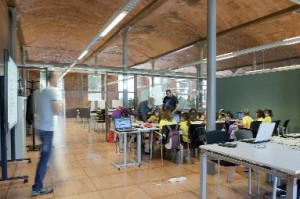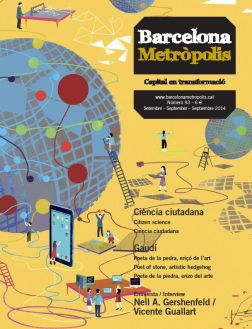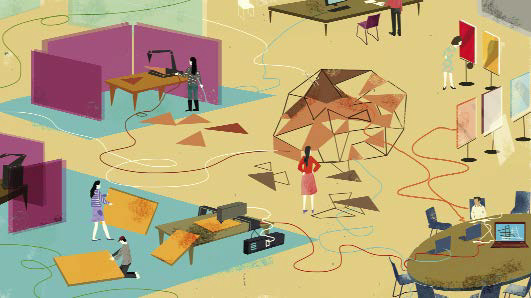We need a new cultural paradigm for the innovation society. We must be able to co-design and learn new cultural patterns, based on increasing each person’s responsibilities with regard to their inventions and use.
In the 19th and 20th centuries, industrialising societies created universal education systems with several tiers: primary school, secondary school and university. These were instrumental in extending literacy among the populace and building up the essential skills that were needed for the industrial economy to expand. In the 20th century, some countries extended this logic to health care, creating primary care, local hospitals and central specialised hospitals. These systems – in Europe at least – democratised health coverage, extending it to the entire population.
Nowadays, in the 21st century, innovation is increasingly recognised as the key to progress and well-being in the knowledge economy. Innovation is central to economic growth and business competitiveness and lies at the heart of the EU’s Europe 2020 strategy (European Commission, 2014). A knowledge economy implies a knowledge society. However, current official innovation systems only include a small minority of our population. We are confronted with the paradox that in a so-called knowledge society an overwhelming majority of its members are outside the system or, at most, just employed as mere “users”.
Nevertheless, there is increasing interest in the opening up of innovation systems. The Internet’s expansion as an open network has made innovative uses of it more widespread. Some of the Net’s architectural principles – like the end-to-end principle, which places the network’s intelligence in its extremes – have favoured the current explosion of applications and services. The beginning of the “collaboratory” concept (Wulf, 1989) has been expanded to a wave of labs of all kinds (fab labs, 2002; citizen labs, 2002; living labs, 2006).
These concerns and the desire for more inclusive innovation systems have crystallised in the birth of the quadruple helix model, in which government, academia, industry and civil society are seen as key actors. A recent report identified the defined “fourth element” in quadruple helix systems as being “ordinary or amateur users, professional users, consumers, employees, residents, citizens, hobbyists, businesses, organizations, or civil society associations” (Arnkil, Järvensivu, Koski & Piirainen, 2010). A new system is emerging.

© Albert Armengol
Image from Tecnostiu, a day of activities at the Citilab in Cornellà during which children and young people come into closer contact with new technologies and TV production.
In the coming decades, this trend could usher in universal innovation systems. These new systems would educate citizens in the essential skills of the knowledge society and provide them with the tools, infrastructure and training to become innovators themselves. Technologies such as Scratch, Arduino, 3D printing, advanced programming, DIY robotics and many others would be present in all towns, villages and neighbourhoods, in a similar way in which Internet, Wikipedia and smartphone devices are made available everywhere through extensive networks of public libraries and hospitals.
Ultimately, city-wide open living labs could become a key driver of local economic growth, dynamising urban economies by enhancing their global competitiveness and sparking a new wave of entrepreneurship. Cities could be turned into innovation hubs, based on the emergence of new kinds of institutions, open living labs, fab labs, citizen labs, edulabs and so on, which would disruptively transform the economic and social fabric of our current cities.
The history of industrial societies proves that it is possible to democratise key skills that have driven a complex economic system, resulting in enormous gains for society at large, as well as some unexpected consequences. Therefore, it makes sense to ask ourselves if innovation can be democratised in a similar way, creating intermediate tiers that extend innovation to all citizens. This century the majority of the world’s population will live in cities, so these areas can play a key role in making the whole planet a more innovative place.
Different possible scenarios loom on the horizon for this “knowledge revolution”. The first one would be the slow opening up of the current triple helix system, which could gradually include citizens’ inputs and needs in the research agenda, while conserving the status quo of the academic and big corporations’ labs. This could be seen as a reform of our current innovation systems. A second, more radical, peer-to-peer scenario would enable citizen labs and other new social innovation movements to generate new research programmes, which could be coordinated globally through the Internet or other networks. Such programmes would provide the tools to design and test urgent social and economic transformations, compelling the official academic establishments to adapt their research programmes to these new situations.
The knowledge era can also produce undesirable consequences. Just as a fab lab can produce wonderful artwork at the same time as a popular craft gun, extending innovative capabilities to the entire population could also give rise to unexpected and unforeseen dangers.
We need a new cultural paradigm for the innovation society. If we are on the brink of an era of disruptive innovation, we must be able to co-design and learn new cultural patterns, based on increasing each person’s responsibilities with regard to their inventions and use. Our societies have been educated to delegate responsibilities and power to heaven, to nature or to parliaments. The more mature and innovative humankind becomes, the greater our degrees of personal freedom and responsibility will be.
The language of innovation
For the first time, we can develop a new way of learning that is closely connected to the innovation system. Our current education system, at least in Western civilisation, can be traced back to Ancient Greece. It was based on the so-called Trivium and Quadrivium. The former entailed learning the natural languages (grammar, logic and rhetoric), while the latter involved learning the formal languages (arithmetic, geometry, astronomy and music). That was the liberal arts curriculum. Practical arts, such as medicine and architecture, had a lower standing.
Now we need a new learning system based on a new layer. We call it the Quintivium. It is based on learning the “language of innovation”. Innovation is not a simple practice. It is a new kind of thinking. Citilab is promoting Scratch as a new language, the language of innovation. Learning to program also means learning how to solve problems and to organise your mind algorithmically. As George Forsythe said, “The most valuable acquisitions in a scientific or technical education are the general-purpose mental tools which remain serviceable for a lifetime. I rate natural language and mathematics as the most important of these tools, and computer science as a third” (What to Do Till the Computer Scientist Comes, 1968).
However, Forsythe did not foresee that the language of innovation would dramatically increase our responsibility as human beings.
We are learning not only to imagine other worlds or to understand the current ones, but to design and build new ones. Just as an engineer or any professional would be held responsible for his or her “deeds”, opening up the “black box” of innovation means that we are all entering into a new era that will bring forth the democratisation of responsibility.




